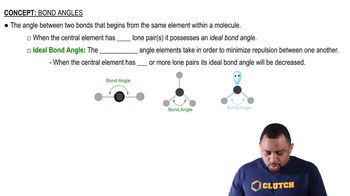Here are the essential concepts you must grasp in order to answer the question correctly.
VSEPR Theory
Valence Shell Electron Pair Repulsion (VSEPR) theory is a model used to predict the geometry of individual molecules based on the repulsion between electron pairs in the valence shell of the central atom. According to VSEPR, electron pairs, whether bonding or lone pairs, will arrange themselves to minimize repulsion, leading to specific molecular shapes and bond angles.
Recommended video:
Molecular Shapes and VSEPR
Molecular Geometry
Molecular geometry refers to the three-dimensional arrangement of atoms within a molecule. The shape of a molecule influences its physical and chemical properties, including bond angles. In the case of BF3 and PF3, the central atom's size and the number of lone pairs affect the overall geometry and the resulting F-X-F bond angles.
Recommended video:
Molecular Geometry with Two Electron Groups
Bond Angles
Bond angles are the angles formed between two adjacent bonds at a central atom. They are influenced by the molecular geometry and the presence of lone pairs. In BF3, the bond angles are expected to be larger due to the absence of lone pairs on boron, while PF3 has a lone pair on phosphorus, which can compress the bond angles, resulting in smaller F-P-F angles compared to F-B-F angles.
Recommended video:




